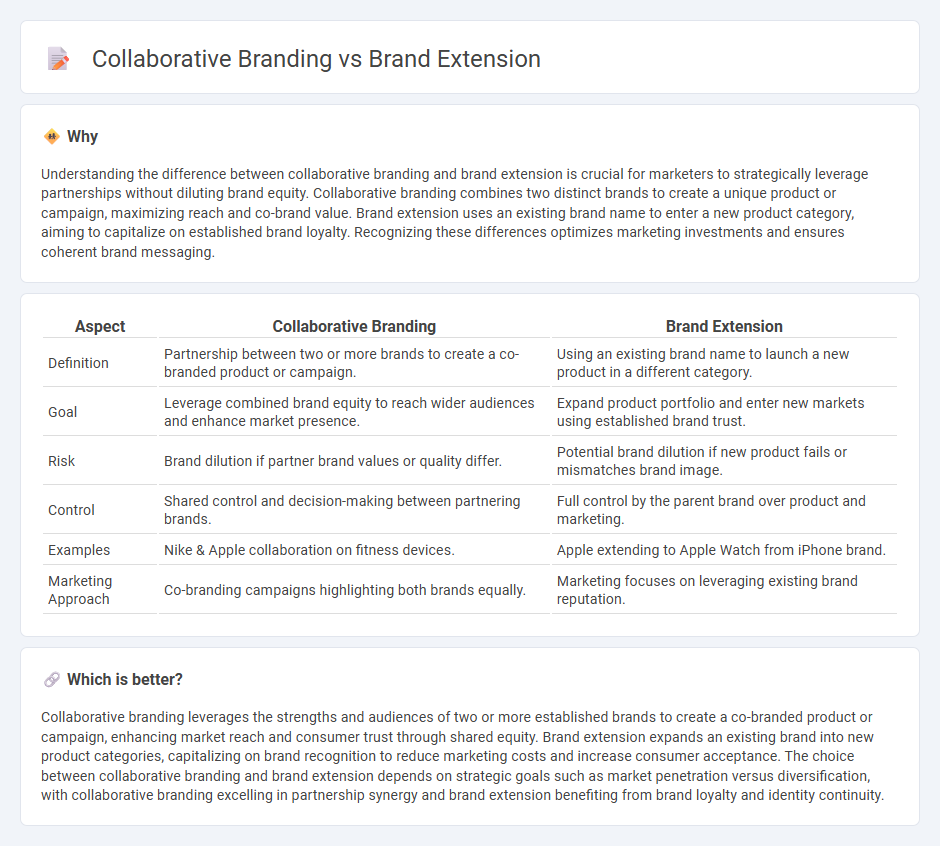
Collaborative branding merges strengths of two or more brands to create a unique market offering, leveraging shared audiences and enhancing brand equity. Brand extension involves expanding an existing brand into new product categories, capitalizing on established brand recognition to reduce launch risks. Explore the nuances and strategic benefits of each approach to optimize your marketing efforts.
Why it is important
Understanding the difference between collaborative branding and brand extension is crucial for marketers to strategically leverage partnerships without diluting brand equity. Collaborative branding combines two distinct brands to create a unique product or campaign, maximizing reach and co-brand value. Brand extension uses an existing brand name to enter a new product category, aiming to capitalize on established brand loyalty. Recognizing these differences optimizes marketing investments and ensures coherent brand messaging.
Comparison Table
| Aspect | Collaborative Branding | Brand Extension |
|---|---|---|
| Definition | Partnership between two or more brands to create a co-branded product or campaign. | Using an existing brand name to launch a new product in a different category. |
| Goal | Leverage combined brand equity to reach wider audiences and enhance market presence. | Expand product portfolio and enter new markets using established brand trust. |
| Risk | Brand dilution if partner brand values or quality differ. | Potential brand dilution if new product fails or mismatches brand image. |
| Control | Shared control and decision-making between partnering brands. | Full control by the parent brand over product and marketing. |
| Examples | Nike & Apple collaboration on fitness devices. | Apple extending to Apple Watch from iPhone brand. |
| Marketing Approach | Co-branding campaigns highlighting both brands equally. | Marketing focuses on leveraging existing brand reputation. |
Which is better?
Collaborative branding leverages the strengths and audiences of two or more established brands to create a co-branded product or campaign, enhancing market reach and consumer trust through shared equity. Brand extension expands an existing brand into new product categories, capitalizing on brand recognition to reduce marketing costs and increase consumer acceptance. The choice between collaborative branding and brand extension depends on strategic goals such as market penetration versus diversification, with collaborative branding excelling in partnership synergy and brand extension benefiting from brand loyalty and identity continuity.
Connection
Collaborative branding leverages partnerships between distinct brands to create joint products or campaigns that amplify market reach and consumer engagement, while brand extension uses an established brand name to launch new products within the same category or different categories, ensuring customer trust and recognition. Both strategies rely on leveraging existing brand equity to enhance visibility, diversify offerings, and reduce market entry risks, promoting sustained growth and competitive advantage. The synergy created between collaborative branding and brand extension drives innovation and reinforces brand identity across multiple consumer touchpoints.
Key Terms
Parent Brand
Brand extension leverages the equity of the parent brand by introducing new products under the same brand name to capitalize on existing consumer trust and recognition. Collaborative branding involves two or more established brands partnering to create a co-branded product, combining their individual brand strengths while maintaining distinct parent brand identities. Explore how these strategies impact brand equity and consumer perception in greater detail.
Co-Branding
Co-branding combines the strengths of two established brands to create a unique product or service, leveraging mutual brand equity to enhance market appeal and consumer trust. Unlike brand extension, which expands a single brand's offerings into new categories, co-branding strategically unites different brand identities to drive innovation and shared customer engagement. Discover more about how co-branding can amplify brand value and competitive advantage.
Brand Equity
Brand extension leverages existing brand equity by introducing new products under the same brand name, aiming to transfer positive consumer perceptions and trust to broaden market reach. Collaborative branding combines the brand equities of two or more established brands to create synergistic value, enhancing customer appeal through shared reputation and co-branding strategies. Discover how these strategies impact brand equity and consumer loyalty in diverse markets.
Source and External Links
Brand extension - Wikipedia - Brand extension is a marketing strategy where a company uses an established brand name to launch a new product in a different category, leveraging existing brand equity to increase awareness and profitability.
What Is Brand Extension? Definition, Types and Examples - Indeed - Brand extension allows companies to reach new customers by offering products in related or unrelated categories under the same trusted brand name, aiming to expand the brand's image and customer base.
Brand Extension: Definition, Examples, Strategies & More - Bynder - A brand extension is a tactic where businesses use their brand recognition to introduce new products or services in different categories, with common types including line extensions and category extensions.
 dowidth.com
dowidth.com